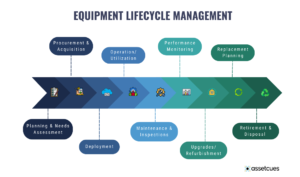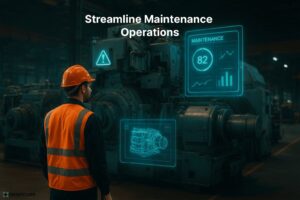Introduction
Unplanned equipment downtime costs industrial manufacturers nearly $50 billion annually, highlighting critical risks. Therefore, effective equipment lifecycle management becomes essential for reducing downtime and improving efficiency. It involves guiding assets from planning and acquisition to operation, maintenance, and retirement. Mastering each lifecycle phase extends equipment lifespans, reduces downtime, and significantly lowers overall operational costs.
Explore AssetCues’ comprehensive guide on asset lifecycle management: from acquisition to disposal
In the sections below, we outline the 9 phases of the equipment life cycle and share best practices at each stage – from setting up preventive maintenance schedules to establishing data-driven replacement criteria – to help you maximize asset value and uptime.
Understanding the Equipment Lifecycle – Key Phases & Best Practices
What are the phases in equipment lifecycle management for machinery?
Equipment lifecycle management can be broken down into 9 key phases covering a cradle-to-grave span from initial planning to final disposal. Each phase needs attention to ensure long-term reliability and efficiency. The phases include:

-
Planning & Needs Assessment:
Evaluate business needs and plan new equipment acquisitions. Audit current assets to identify gaps and ensure any new machinery aligns with strategic goals and budget.
-
Procurement & Acquisition:
Follow proper purchasing processes to source and acquire the equipment. Set technical specifications, vet vendors, and decide whether to buy or lease the asset.
-
Deployment & Commissioning:
Install and configure the new equipment. Set it up, check it for any defects, and register the asset in your tracking system to begin its service life.
-
Operation/Utilization:
Operate the equipment under normal working conditions. Ensure proper use by training operators and following standard procedures so that misuse doesn’t cause premature wear.
-
Maintenance & Inspections:
Perform regular upkeep to keep the asset running reliably. Schedule preventive maintenance tasks (inspections, lubrication, parts replacements) and periodic safety checks throughout its operation to maximize uptime.
-
Performance Monitoring:
Continuously track the asset’s performance and condition. Monitor key metrics such as uptime, output, downtime, and maintenance costs to spot trends or warning signs early, enabling timely interventions.
-
Mid-Life Upgrades/Refurbishment:
At mid-life, consider refurbishing or upgrading the equipment if beneficial. Overhauling critical components or retrofitting new technology can extend its useful life instead of requiring a brand-new replacement.
-
Replacement Planning:
As the asset nears end-of-life, decide whether to keep maintaining it, undertake a major overhaul, or replace it with a newer model. Use data on its performance, repair frequency, and costs to inform this decision.
-
Retirement & Disposal:
Safely retire the asset from service and dispose of it responsibly. This could involve reselling it, trading it in, recycling it for parts/scrap, or decommissioning it according to environmental and safety regulations. Don’t forget to update asset records and financials once the asset is disposed.
These nine stages ensure you manage the asset from cradle to grave. (Some models simplify this into fewer stages like plan, acquire, use, maintain, dispose, but breaking it into nine highlights each step.) The takeaway: applying best practices at each phase leads to more efficient asset utilization and lower lifecycle costs.
Learn how to manage every stage of the asset lifecycle effectively>>
Best Practices Across the Lifecycle
Certain foundational practices apply across multiple phases of the asset lifecycle. Implement these strategies to set your program up for success:
-
Policy & Documentation:
Maintain clear policies and documentation at every stage. Log each asset in a central register from day one, and keep maintenance procedures, inspection checklists, and disposal records up to date. Good documentation ensures consistency, aids compliance, and prevents “ghost assets” (disposed assets still listed on the books).
-
Lifecycle Data & KPIs:
Track key data for each asset throughout its life – usage hours, maintenance history, failures, downtime, and costs. Using an EAM/CMMS system to record this data provides insights for improvement. For example, analyzing trends might reveal a machine whose maintenance costs spike after a certain period, prompting an adjusted schedule or earlier replacement plan.
-
Cross-Functional Collaboration:
Involve multiple departments (Operations, Maintenance, Finance, IT, etc.) in asset lifecycle planning and decisions. Each brings a perspective: finance on budget and depreciation, maintenance on equipment condition, IT on technology integration, and so on. A cross-functional approach ensures asset decisions align with overall business objectives rather than being made in silos.
By adopting these practices, organizations shift from reactive fire-fighting to a proactive, structured asset management approach. Fewer surprises and emergencies mean more predictable and cost-effective asset performance.
Preventive & Predictive Maintenance – How to Extend the Equipment Life Cycle
-
How can I extend the life cycle of factory equipment?
Extending an asset’s life cycle requires diligent maintenance and smart daily operation. Scheduled preventive maintenance with quality parts ensures equipment reliability and reduced failures. Moreover, training operators and leveraging IoT sensors enables predictive maintenance with efficiency. These actions prevent run-to-failure scenarios, keeping assets reliable and minimizing costly breakdowns.
-
Preventive Maintenance Best Practices
Preventive maintenance is critical. Always follow the recommended service intervals, use a checklist so no task is missed, and stick to the manufacturer’s procedures using approved parts.
-
Embracing Predictive Maintenance (IoT & Analytics)
Predictive maintenance uses sensor data and analytics to perform maintenance only when needed – right before a potential failure. Instead of servicing on a fixed schedule, you monitor the equipment’s actual condition in real time and act on early warning signs. This approach can significantly reduce unplanned downtime and extend equipment life.
Refurbishment and Life-Extension Tactics
Mid-life refurbishment can extend an asset’s useful life at a fraction of the cost of buying new. If an overhaul can restore performance for under about half the price of a replacement, it’s often worthwhile. Just be sure to use certified technicians, high-quality parts, and thorough testing so the refurbishment truly “resets” the asset’s life in a reliable way.
Equipment Replacement & Retirement – Deciding When It’s Time for an Upgrade
When should you replace an aging asset instead of repairing it?
Replace an asset when it’s no longer cost-effective or safe to keep running. If a repair or overhaul would cost around 50% or more of a new replacement, or if the equipment keeps failing, performs poorly, or has safety issues due to age, it’s probably time to replace it.
-
Key Criteria for Repair vs. Replacement
When weighing repair vs. replacement, consider factors like cost, age, performance, reliability, safety, and technology. Rising maintenance costs, an old asset at the end of its life, frequent breakdowns, safety or compliance problems, or outdated, inefficient technology all point toward replacement being the smarter choice.
-
Retirement Planning and Disposal
Plan asset retirements proactively instead of waiting for catastrophic equipment failures. During retirement, follow safe decommissioning steps like shutting power and removing hazards. Additionally, select optimal disposal options such as resale, trade-in, recycling, or scrapping. Finally, update records promptly to eliminate phantom ghost assets and maintain accurate books.

Optimize Your Asset Lifecycle Management with AssetCues
From automated tracking to insightful analytics, see how AssetCues helps reduce costs and improve efficiency—request a demo or contact our team today.

Optimize Your Asset Lifecycle Management with AssetCues
From automated tracking to insightful analytics, see how AssetCues helps reduce costs and improve efficiency—request a demo or contact our team today.
Still Not Sure RFID or Barcode, Which One Is Right for You?
Our experts have over a decade of experience in asset tracking and can guide you further based on your requirements
Optimization Techniques to Reduce Downtime and Boost Asset Performance
-
Monitor Performance with Data & KPIs
Track key performance metrics (uptime, output, MTBF, etc.) for each asset and use dashboards or reports to catch issues early.
-
Optimize Asset Utilization & Workload
Distribute work evenly across your machines and schedule maintenance during low-demand periods to avoid unnecessary wear or downtime.
-
Streamline Maintenance Operations
Fix issues quickly and efficiently: use a maintenance system to prioritize repairs, keep critical spare parts on hand to avoid delays, train your team well, and use modern tools (like mobile apps or AR support) to speed up troubleshooting and repairs.

Continuous Improvement & Lifecycle Planning
Treat asset management as a continuous improvement cycle for long-term efficiency. Regularly review performance data with teams to identify weak points and costs. Then, apply insights to improve decisions, equipment choices, or maintenance intervals. Finally, update your asset plan consistently, ensuring strategies remain relevant and effective.
Strategic Asset Lifecycle Planning in the Digital Era
Asset lifecycle management isn’t just an operational task – it can also be strategic. Aligning your asset plan with digital technology and overall business goals is crucial:
-
Data-Driven Asset Management Strategy
Centralize your asset data in one system and use analytics to guide major decisions. Analyze maintenance trends to know when an asset’s rising costs justify replacement. Also consider the total life cycle cost of assets (maintenance, downtime, energy, etc.) when evaluating purchases or replacements.
-
Embracing Digitization & IoT for Lifecycle Management
Embrace digital tools to optimize asset management and maximize operational efficiency. IoT sensors provide real-time visibility, instant alerts, and timely maintenance actions. Furthermore, advanced analytics and AI predict failures and recommend optimal maintenance schedules. Even small digital upgrades significantly improve uptime while reducing operational costs and equipment risks.
Aligning Asset Strategy with Business Goals
Your asset lifecycle strategy should support your company’s broader objectives. Asset plans and decisions need to align with what the business is trying to achieve:
-
Strategic alignment:
Tie asset plans to company goals. If the company prioritizes sustainability, focus on energy-efficient, long-lasting equipment; if expansion is a goal, plan what new assets are needed.
-
Risk management:
Plan maintenance and replacements to prevent major breakdowns that could disrupt operations.
-
Adaptability:
Regularly update your asset plan for new developments (regulations, technologies, market shifts). Adjusting proactively means you’re prepared for changes instead of scrambling later.
-
Change management:
When introducing new asset management processes or tech, train your staff and clearly communicate the benefits. Getting buy-in from maintenance crews and operators makes new initiatives more likely to succeed.
Aligning asset lifecycle management with business strategy helps your company run more efficiently, reliably, and competitively, instead of just reacting to asset problems.
FAQ
Q: What is equipment lifecycle management?
A: Equipment lifecycle management is the practice of managing equipment from purchase through operation to disposal. It ensures assets are properly maintained, tracked for cost and performance, and retired at the right time. This approach helps Finance control costs, IT reduce downtime, and Audit verify compliance at each stage.
Q: What’s the difference between preventive and predictive maintenance?
A: Preventive maintenance is routine service at scheduled intervals no matter what; predictive maintenance is guided by sensor data and done only when needed based on the equipment’s condition.
Q: How can IoT help in equipment lifecycle management?
A: IoT sensors continuously report equipment conditions, enabling predictive maintenance (fixing issues before failures) and giving managers real-time visibility to optimize asset use and decisions.
Q: What software tools can we use to manage the asset life cycle effectively?
A: Use an EAM or CMMS platform to manage assets efficiently across their lifecycle. Tools like AssetCues centralize tracking, maintenance scheduling, and performance analysis seamlessly. Moreover, advanced systems provide dashboards, alerts, and IoT integration for smarter insights. Centralized management prevents gaps while enabling data-driven decisions that boost performance and longevity.
Simplify Asset Lifecycle Management
Schedule your personalized demo to unlock efficiency at every stage.
Simplify Asset Lifecycle Management
Schedule your personalized demo to unlock efficiency at every stage.
Conclusion & Call-to-Action
Effective asset lifecycle management transforms manufacturing enterprises by driving efficiency and cost savings. Proactively managing every phase, from planning to retirement, extends asset lifespans significantly. Moreover, IoT data and analytics enhance reliability, safety, and operational decision-making. This holistic approach ensures minimal downtime, safer conditions, and maximum ROI from assets.
Today, companies that excel at asset lifecycle management will outpace those that remain reactive. They’ll have more reliable equipment, lower maintenance expenses, and greater agility to meet business goals.
Now apply these practices across your organization for stronger asset management results. Identify improvements in every lifecycle stage through better maintenance, training, or technology. An integrated platform like AssetCues unifies data, scheduling, and performance analytics seamlessly. With a smart lifecycle strategy, you’ll achieve minimal downtime, extended asset life, and higher ROI.
About Author






